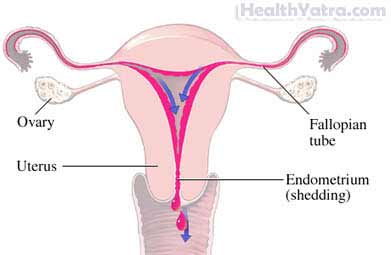Definition
Menstruation, or a menstrual period, refers to the monthly process in which the uterus sheds blood and tissue in preparation for pregnancy.
Not having or missing a menstrual period is called amenorrhea. This condition is divided into two types:
- Primary amenorrhea—when an adolescent female has not yet begun menstruation by around age 16 years
- Most females begin menstruating between the ages 9-18, but age 12 is the average.
- Secondary amenorrhea—when a woman who has previously menstruated misses three or more periods in a row

Causes
The most common cause of secondary amenorrhea is pregnancy. If nonpregnant women, may be due to a variety of factors.
Risk Factors
Factors that may increase the risk of amenorrhea include:
- Dramatic weight loss (eg, from extreme diets, eating disorders, or excessive exercise) or dramatic weight gain
- Malnourishment
- Birth defects (eg, lack of female reproductive organs)
- Chromosomal or hormonal abnormalities
- Certain conditions (eg, thryoid disorder, pituitary tumor)
- Medicines (eg, certain contraceptives)
- Emotional distress
- Uterine scarring
Symptoms
The main symptom for primary amenorrhea is the absence of a menstrual period in a female by age 16 or older. The main symptom for secondary amenorrhea is three or more missed periods in a row in a woman who has previously had menstrual periods.
When Should I Call My Doctor?
Call your doctor if you:
- Have not had your first period and are aged 16 years or older
- Miss having your period
Diagnosis
Your doctor will ask about your symptoms and medical history. A physical exam will also be done.
Tests may include:
- Pregnancy test
- Progestin challenge test to determine if a lack of estrogen is causing amenorrhea
- Blood work to check hormone levels
- Chromosome test to determine if there are any abnormalities
Other tests that may be ordered include:
- MRI scan of the pituitary gland
- Ultrasound
Treatment
Treatment will depend on what is causing amennorhea. Examples include:
- Weight-related cause—A healthy caloric intake and exercise routine usually restores hormonal balance and menstruation.
- Birth defect—Surgery may be needed.
- Hormonal irregularity—Your doctor may prescribe hormonal therapy.
- Emotional distress—Relaxation techniques (eg, deep breathing), therapy, and exercise may help to decrease stress.
- Pituitary tumor—Surgery, radiation therapy, or medicine may be needed.
Prevention
There are no clear guidelines for preventing amenorrhea.
Absent Periods Treatment in India Page Keywords:
Absent Periods Definition, Definition Causes, Absent Periods Symptoms, Absent Periods Treatment in India, Absent Periods Treatment Cost in India, Absent Periods Surgery Cost, Top Absent Periods Treatment Hospital, Top Absent Periods Treatment Doctor in India, Absent Periods Meaning in Marathi, Absent Periods Treatment Near me, Absent Periods Complications, Travel India for Absent Periods Treatment, Absent Periods Treatment in Arab Countries, Absent Periods Treatment in Bangladesh, Absent Periods Treatment in Dhaka, Absent Periods Meaning in Bengali, Absent Periods Meaning in Arabic, Absent Periods Meaning in Hindi, Absent Periods Treatment in Bahrain, Absent Periods Treatment in Egypt, Absent Periods Treatment in Iraq, Absent Periods Treatment in Jordan, Absent Periods Treatment in Kuwait, Absent Periods Treatment in Lebanon, Absent Periods Treatment in Saudi Arabia, Absent Periods Treatment in United Arab Emirates, Absent Periods Treatment in Sudan, Absent Periods Treatment in Tunisia, Absent Periods Treatment in Nepal, Absent Periods Treatment in Nepal,
Absent Periods Meaning in Bengali, Absent Periods Meaning in Arabic, Absent Periods Meaning in Hindi, Absent Periods Meaning in Marathi
